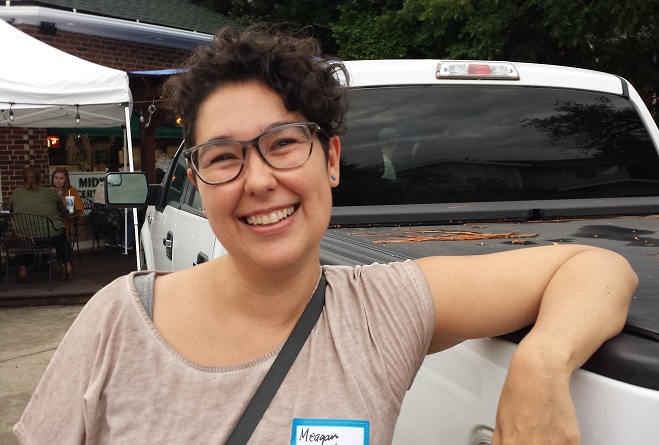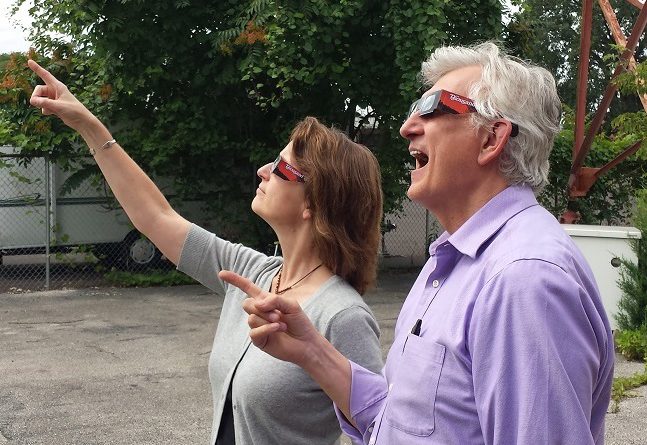August 19, 2017 – The Dark Side of the Sun
![]() Let’s get something straight. My goals this weekend are modest. Very modest. Here’s what I hope to achieve:
Let’s get something straight. My goals this weekend are modest. Very modest. Here’s what I hope to achieve:
- On today’s show, get some basic information about Monday’s total solar eclipse from NASA Scientist Meagan Thompson. (I want to make sure that you don’t hurt yourselves.)
- I want to get some sleep tonight. (Think four year-old on Christmas Eve.)
- Tomorrow, I want to get through the show without tripping over any audio cables or snorting coffee through my nose.
- Then pick up Kathleen and head to southern Illinois, to a little town called Grayville, where we will spend the night about 50 miles from the path of totality.
- Finally (and this is the truly scary part), get up early on Monday and hope that in six hours or so, we can manage to travel 50 miles…along with another 200,000 people or so (that’s the number that are reportedly headed downstate for the not-quite-once-in=a-lifetime event).
That’s all I want to accomplish. Really. I just want to see a total eclipse of the sun once in my lifetime! Is that too much to ask? Now, all that is standing in my way is a crowd the size of five Wrigley Fields, which is trying to get to roughly the same spot at the same time. What could possibly go wrong?
But back to Meagan Thompson, who is on today’s show. You need to know a few things. First, she is related to my life partner Kathleen Thompson, so, in a way, she’s part of the family. Also, I got to meet her in Norman, Oklahoma last weekend (which is where the photo comes from). Last, but by no means least, she works at NASA Headquarters in Washington, D.C. Here’s how she describes her work:

I am a contractor, employed by Arctic Slope Regional Corporation, working on the NASA Research and Education Support Services contract. I am assigned to NASA Headquarters, where I work within the Division of Planetary Science. My official title is Senior Scientist and I am the lead program scientist for a technology a program called Concepts for Oceanworlds Life Discovery Technology (COLDTech), which is specifically interested in novel technologies that could be used to facilitate the search for life on the icy/watery moons of the outer planets.
She continues,
My background is in geophysics and solid state physics, where I used computational techniques from solid state physics to create models of planetary interiors to help understand the dynamics of planetary interiors. So, strictly speaking, I’m not a heliophysicist or a scientist who studies eclipses. However, I’ve been interested in eclipses since I saw the partial eclipse in 1984. Scientifically, I’m most interested in the magnetospheric studies that will be facilitated during the coronal stage of the eclipse, and I’m very interested in all the citizen science that NASA has coordinated across the country. It’s an exciting time to work at NASA Headquarters!
Ya think? Not only is she a senior scientist, but she told me in person that when it comes to All Things Eclipse, her job description is “Official Eclipse Subject Matter Expert for NASA.” I kid you not.
In fact, she’s one of the people holding down the fort at NASA on Monday, when most of the scientists will be trying to find a spot next to the millions of people who will be jamming the narrow path of totality across the country. So she will be answering a lot of questions–some of them from Peggy and me.
I’m not going to go into all of things you should or shouldn’t do on eclipse day, since you can Google that and come up with a few hundred thousand sites in a nanosecond. However, here are a few sites that might help.
- https://eclipse2017.nasa.gov/ (a comprehensive eclipse site from NASA)
- https://nasa.tumblr.com/post/164302686709/eclipse-2017-a-unique-chance-for-science (a tumblr NASA site that highlights a lot of cool science that will be going on)
- Your solar eclipse checklist: What to look for on the big day (a very interesting article from the LA Times about some things to focus on during the event)
- Total Solar Eclipse 2017 App! (you knew there had to be one)
- Vendors may be selling ‘fake’ solar eclipse glasses. Here’s how to make sure yours are real (things don’t get much more important than this story from the Washington Post)
Finally…don’t you dare look at the sun unless you have your solar eclipse glasses!!!
Okay. A couple of radio shows and I’m off to southern Illinois. Whoo-hoo!

